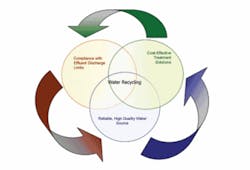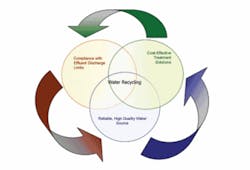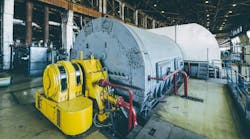by Cameron Wilson
• Frost & Sullivan assesses market outlook for water and wastewater treatment for the North American food & beverage industry.
Historically, the food and beverage industry has been a consumer of large volumes of water. A consistent and reliable supply of high quality water is of vital importance to the industry. Not only is water included as an ingredient in the finished products, but it's also used in many processes that generate these end products. Industry standards require the water meet strict quality requirements. Specifically, water used as process water must meet the same standards as drinking water. To ensure there are no interferences with the flavor or color of the finished products, sometimes even potable drinking water must be treated to remove dissolved constituents that could compromise quality. Depending on the source of water used by the processor and the intended use, there are a number of possible treatments the water must undergo before it's used. For the most part, food and beverage processors rely on municipal water to supply their processes.
Discharges of process effluent must also be treated to comply with regulatory guidelines. Process water often carries contaminants that must be removed before it's discharged to the environment. Whether this effluent treatment is carried out onsite or offsite depends on the process and costs associated with treatment. Capital investment in treatment technologies can often be cost prohibitive, in which case processors may discharge their effluent to the municipal sewer for treatment at a public facility. Costs of onsite vs. offsite treatment must be compared to determine the best solution for the plant.
In Short Supply
Recently, winds of change have been blowing, and municipal water may turn out to be the less economical choice for industries that traditionally use such large volumes. Municipalities are feeling the crunch of increasing treatment costs and have started to raise their rates. Households using an average of 70 gallons per day (gpd) of water likely wouldn't even notice a 1 cent/gallon hike on their water bill, but a food processing plant that uses up to 1 million gpd could be crippled by such a hike. Companies must weigh the costs of increasing water rates against the possibility of drawing water from the environment and treating it themselves. Generally, the untreated ground or surface water will be of lower quality than a municipal supply, but in some cases, even municipal water must be treated to remove impurities. With that in mind, the industry could choose to accept cheaper water that requires a higher degree of treatment over the higher quality source.
Luckily, technology exists to treat sub-quality water to meet process water as well as wastewater discharge requirements. A number of companies offer complete treatment packages to service this industry. Treatments include screening and separation of suspended matter, disinfection (either chemical or physical), reverse osmosis to remove dissolved contaminants, and activated carbon filtration to remove organics.
Tougher Rules in Mail
As industrial water users go, the food processing industry is relatively clean in that it doesn't produce any persistent organic by-products. Historically, the quality concerns in food process effluents mainly revolved around properties such as pH, biochemical oxygen demand (BOD), and total suspended or dissolved solids (TSS/TDS). The USEPA, however, recently revisited the direct-discharge effluent guidelines for the meat and poultry processing sector, adding nutrients such as nitrogen and phosphorus to the list of regulated parameters. Nutrients are of special concern due to their effect on natural water systems. For instance, ammonia nitrogen is toxic to aquatic organisms while phosphorus promotes growth of algae that could negatively affect the ecological balance of lakes and rivers. Future regulatory changes can be expected to affect other sectors of the food processing industry in the coming years. These direct discharge guidelines only apply to processors that discharge their effluent to the environment.
Recycling Wastewater
Trends are leading toward recycling process water. Presently, the majority of food processors provide at least some measure of effluent treatment on site, though the technologies employed will differ depending on the type of process the plant utilizes. Relatively few plants treat their effluent entirely onsite, instead electing to handle primary treatment themselves and discharge the remaining effluent to their municipal sewer system for further treatment. As a result, food processors are once again at the mercy of the municipalities. In smaller municipalities, a food processing plant has the potential to discharge more water then the rest of the population of the town. It's for this reason many municipalities are tightening discharge guidelines/standards and increasing fines for exceeding them to recover treatment costs. The food and beverage industry is thus encouraged to recycle its process water wherever possible. Figure 1 illustrates how water recycling can address the issues of securing a reliable source, while reducing effluent discharge costs. In this case, similar treatment technologies would apply to the effluent in order to meet the quality requirements of process water. It is unlikely that recycled water would be used as an ingredient in an end-product.
Cost Drives Technology
For food processors, the decision to treat their own water is solely dependent on cost efficiency. On the front end, the cost of water plus treatment will decide the chosen water source. If a plant can obtain groundwater for free and bring its quality into compliance with its needs for less than the cost of municipal water, it will do so. On the back end, plants aim to treat water cost effectively – such that it can be recycled, or at least discharged without any monetary consequences. Treatment solutions that reduce overall costs are coveted and available. A plant must analyze the costs to determine if operations and maintenance savings of the treatment systems over discharge fines will justify the capitol costs of installing a more advanced treatment system. As compliance with discharge requirements becomes more expensive, internal treatment solutions become more attractive. Furthermore, increasing scarcity of water resources is making water recycling a more viable option.
Conclusion
In the food and beverage processing industry – like anywhere else – the bottom line rules. Providers of water treatment solutions must identify opportunities where their products are the most cost-effective to their customer. Regions where municipal sewer discharge guidelines are more progressive (i.e., more stringent), and fines are more prevalent represent areas that are prime targets for larger and more comprehensive on-site effluent treatment systems. Food processors in regions with water scarcity issues (or where water resources are increasing in price) could be ideal candidates for treatment systems that offer the possibility of process water recycling, allowing the plant to optimize its water use.
About the Author: Cameron Wilson is a research analyst in Palo Alto, CA-based global growth consulting company Frost & Sullivan's Environmental & Building Technologies practice. Contact: [email protected] or www.frost.com


